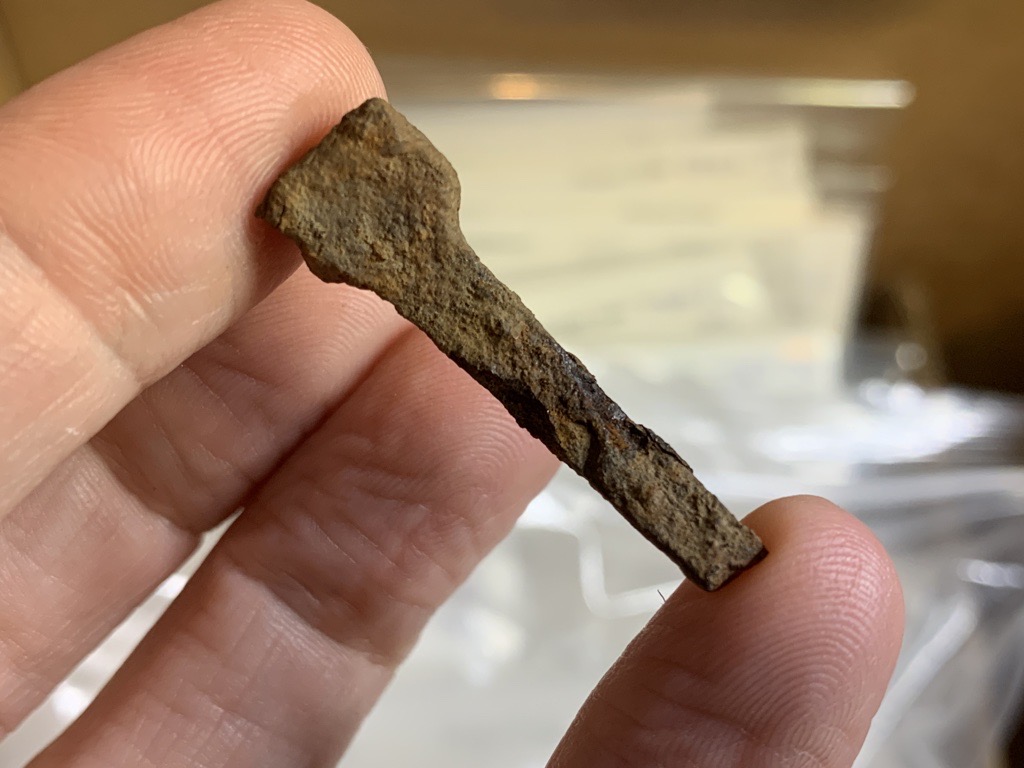The Humble Horseshoe Nail

Nails are common finds on historical archaeological sites in Ontario, including both nails for construction and those used to shoe horses- like the example depicted here. Aside from representing the activity of shoeing a horse, the presence of a large quantity of horseshoe nails can help determine patterns of use on a site. This is […]
Setting the Scene: Landscapes and Place-making in CRM
Cultural Resource Management (CRM) archaeology favours the clarity and efficiency of technical reports in communicating with clients, governments, and colleagues. Yet archaeology is an imaginative, empathetic practice that relies on field crews making observations and developing knowledge of the landscapes in which they work. Stepping beyond reports and weaving these data and experiences into stories […]
Tracing the Irish Famine Diaspora through Archaeology
The Great Irish Famine of 1845-1852 was a watershed moment, not only for Ireland but also for the countries that absorbed the over 2 million famine emigrants forced to leave their homeland. These victims were often painted as a monolithic peasantry with limited agency; however, the archaeological study of the Irish Famine on both sides […]
Storytelling Through Storymaps: A nineteenth century immigrant experience through the lens of CRM archaeologists
Nestled in farmland slated for development in Burlington, Ontario, is a site that tells a familiar story of nineteenth century immigration. Multiple families moved to Canada and set up roots in a rural community, building a new life for themselves and their descendants. Almost two hundred years later, a group of archaeologists began to uncover […]
A Late Archaic Smallpoint Horizon Conundrum
Excavations at the multi-component Gehl Site in Kitchener, Ontario, Canada resulted in the recovery of more than 50,000 lithic artifacts. During lithic analysis of the site’s assemblage at least one pattern began to emerge focused on one temporal period of Ontario’s past: the documentation of 71 Late Archaic Smallpoint Horizon Expanding Stem projectile points of […]
Modelling Artifact Surface Visibility in the Ploughzone
Most lands subjected to archaeological assessment in Ontario have been intensively cultivated for a century or more. The visibility of artifacts on the ploughzone surface is the primary factor influencing site identification in this context, but the relationship between surface artifact samples and the underlying ploughzone assemblage is poorly understood. This paper reviews relevant research […]
Landscape of Nations: Beyond the Mist

The Niagara Parks Commission, in association with Plenty Canada, published Landscape of Nations: Beyond the Mist, a 256-page coffee table book featuring works from 17 authors, numerous photographers, mapmakers and artists, that chronicles the history of Indigenous peoples who have lived within the Niagara region for some 13,000 years. This anthology reveals an unprecedented examination […]
Industrial Development at the Mouths of Garrison and Taddle Creeks: Landscape Adaptation, Transformation, and Disappearance on Toronto’s Waterfront
The railways and growing industries began altering Toronto’s waterfront on a large scale in the mid-nineteenth century, 40 to 50 years after the founding of the Town of York (Toronto). Garrison Creek, at the entrance to the harbour west of the early town, and Taddle Creek, which emptied into the bay at the east edge […]
Teaching Curation: Using Collections to Foster Disciplinary Reflection and Research Opportunities among Undergraduates
Despite decades-long acknowledgment of a curation crisis, undergraduate education in archaeology continues to emphasize excavation as central to the discipline and to our understanding of the past. Moreover, lab classes that emphasize analytical skills are more common than those that teach curation procedures. Whether consciously of it or not, this conveys to our students that […]
Creamware

Creamware is a glazed refined earthenware with a body that ranges in colour from ivory, light cream to straw. The creamy yellow glaze is caused by the addition of copper to a clear lead glaze. During the manufacturing process creamware is fired twice. In the first stage, the vessel is fired to a bisque. This […]


